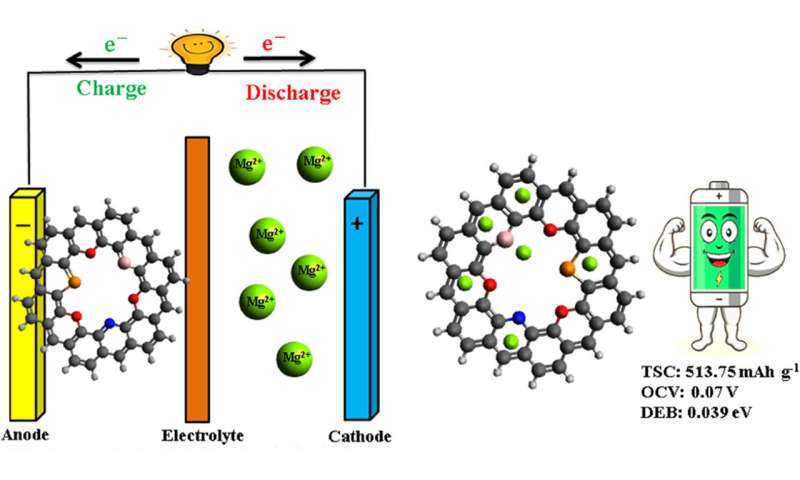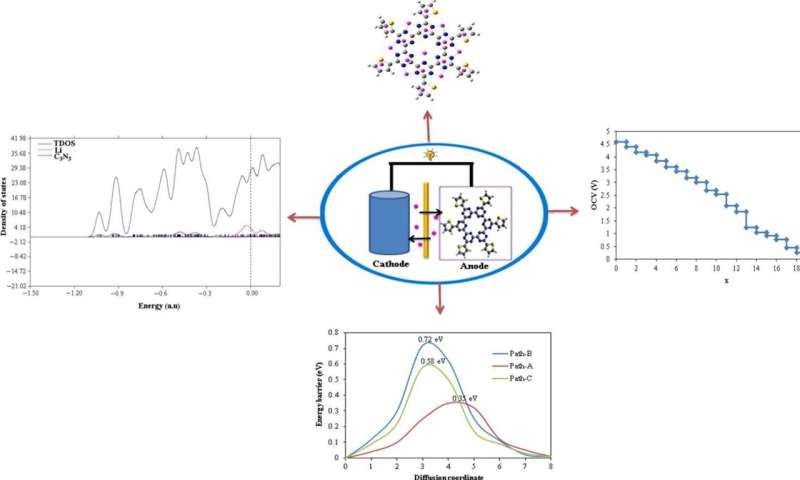KFU scientists offer new solutions for metal-ion batteries

Employees of the Institute of Physics of Kazan Federal University and their overseas colleagues have proposed the structures of new materials of oxotriarylmethyl solubilized with heteroatoms (B/N/P@oxTAM) and C3N3 nanosheet functionalized with thiophene, which can become an environmentally friendly and more energy-efficient alternative to traditional anode materials of metal-ion batteries. The research was conducted as part of the Priority 2030 strategic academic leadership program.
In the context of current fossil fuel challenges, clean and renewable alternatives are being sought—solar, geothermal, biomass, water, tidal, and wind sources. However, due to the limitations of green energy and its dependence on external conditions, the issue of developing efficient energy storage systems becomes extremely important.
Modern hybrid cars and portable electronics run on high-power batteries. These are metal-ion batteries, especially lithium batteries. They are small in size and have competitive characteristics—high energy density, long life, high voltage, low self-discharge rate. Although metal-ion batteries are currently the most commonly used energy storage devices, the use of traditional inorganic electrodes in them requires the search for more sustainable and environmentally friendly alternatives. In addition, scientists are challenged to find materials with higher effective capacity and extended lifetime.
Thus, as a viable anode material for metal-ion batteries, Kazan University scientists have proposed oxotriarylmethyl co-ligated with heteroatoms (B/N/P@oxTAM).

Irina Gumarova, Lead Research Associate at the Laboratory Computer Design of New Materials and Machine Learning of the Institute of Physics, notes that due to its low no-load voltage and diffusion energy barrier, as well as high theoretical specific capacitance, the material has an extended life cycle and high charge-discharge rate.
"The structure and properties were investigated using computer modeling based on density functional theory. In this work, it was shown that B/N/P@oxTAM is a highly porous structure and has high adsorption capacity. Also, its partial density of states, no-load voltage, theoretical specific capacitance and diffusion energy barrier were calculated and studied for this compound. And it was shown that the proposed anode material has a high theoretical specific capacitance of 513.75 mAh/g and a low no-load voltage of 0.07 V," comments Gumarova.
The nanosheet C3N3, to which thiophene groups are attached, has similar properties, she adds. Due to its excellent characteristics—high theoretical specific capacitance, small diffusion barrier and low operating voltage—the compound can be used in the production of lithium-ion batteries.
"This compound belongs to the class of so-called covalent triazine frameworks. Over the last couple of years, this class of compounds has become particularly popular in material development for metal-ion batteries due to their unique combination of properties. For example, their rigid triazine bonds provide chemical and physical stability, while the presence of one-dimensional open channels and large interlayer spaces improves electrochemical performance," says Gumarova. "Despite their numerous advantages, their use in metal-ion batteries is complicated by such problems as low solubility in aprotonic electrolytes and insufficient conductivity. In addition, the limited number of active positions for adsorption of metal atoms in the structure limits the available battery capacity, which affects their efficiency. In our research, we look for new materials through computer modeling of various modifications of the structure and composition of covalent organic frameworks in order to overcome the above problems. For example, doping, substitution of parts of the structure, attachment of additional functional groups and creation of composites with other materials are supposed to increase solubility, porosity, conductivity and the number of adsorption positions for metal atoms. Such modifications of the structure can not only further improve the possibilities of electrochemical energy storage, but also provide prospects for improving the electrochemical properties of the material as a whole."
The research was carried out by scientists of Kazan Federal University—lead research associates Sadegh Kaviani, Irina Gumarova, and Associate Professor of the Department of General Physics Oleg Nedopekin, under the supervision of the First Vice-Rector, Chair of the Department of General Physics Dmitry Tayurskii, together with Iranian colleagues—Dr. Rezvan Rahimi of the Department of Chemistry, Arak University (Markazi, Iran), Professor Ehsan Shakerzadeh of the Department of Chemistry, Shahid Chamran University in Ahvaz (Khuzestan, Iran).
More information:
A DFT-based design of B/N/P-co-doped oxo-triarylmethyl as a robust anode material for magnesium-ion batteries
www.sciencedirect.com/science/ … 0378775324003768?via%3Dihub
Unveiling potential of thiophene-functionalized C3N3 nanosheet as an anode for Li-ion batteries: A DFT-D3 study
www.sciencedirect.com/science/ … 138770032400474X?via%3Dihub
Provided by Kazan Federal University